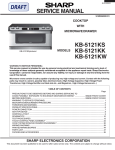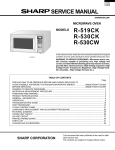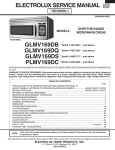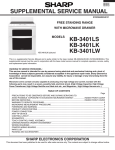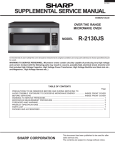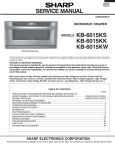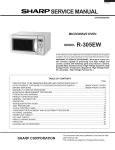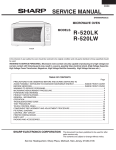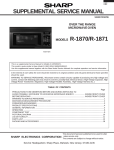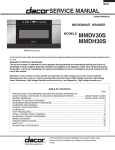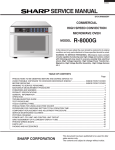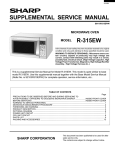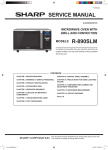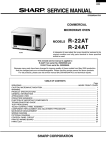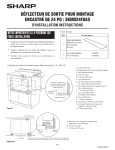Download Sharp KB6002LK Service manual
Transcript
KB-6002LS KB-6002LK KB-6002LW SERVICE MANUAL S76R265KB6002 MICROWAVE DRAWER Sensor M icrowave D rawer MODELS KB-600LWpictured KB-6002LS KB-6002LK KB-6002LW Intheinterestofuser-safetytheunitshouldberestoredtoitsoriginalconditionandonlypartsidenticaltothosespecifiedshould beused. WARNING TO SERVICE PERSONNEL: This service manual is intended for use by persons having electrical and mechanical training and a level of knowledge of these subjects generally considered acceptable in the appliance repair trade. Sharp Electronics Corporation cannot be responsible, nor assume any liability, for injury or damage of any kind arising from the use of this manual. Microwave ovens contain circuitry capable of producing very high voltage and current. Contact with the following parts may result in a severe, possibly fatal, electrical shock. (High Voltage Capacitor, High Voltage Power Transformer, High Voltage Rectifier and Heat sink etc., and Magnetron, High Voltage Harness etc..) TABLE OF CONTENTS Page PRECAUTIONSTOBEOBSERVEDBEFOREANDDURINGSERVICINGTO AVOIDPOSSIBLEEXPOSURETOEXCESSIVEMICROWAVEENERGY..................... INSIDEFRONTCOVER BEFORESERVICING....................................................................................................... INSIDEFRONTCOVER WARNINGTOSERVICEPERSONNEL................................................................................................................. 3 MICROWAVEMEASUREMENTPROCEDURE..................................................................................................... 4 FOREWORDANDWARNING............................................................................................................................... 5 PRODUCTSPECIFICATIONS............................................................................................................................... 6 SCHEMATICS...................................................................................................................................................... 10 TESTPROCEDURES.......................................................................................................................................... 11 TOUCHCONTROLPANELASSEMBLY.............................................................................................................. 19 MICROWAVEDRAWERDISASSEMBLY............................................................................................................. 7 WIRINGDIAGRAMS............................................................................................................................................ 31 PRINTEDWIRINGBOARDS............................................................................................................................... 3 PARTSLIST......................................................................................................................................................... 36 PACKINGANDACCESSORIES.......................................................................................................................... 41 SHARP ELECTRONICS CORPORATION Thisdocumenthasbeenpublishedtobeusedforaftersalesserviceonly.Thecontentsaresubjecttochangewithoutnotice. 1 KB-6002LS KB-6002LK KB-6002LW PRECAUTIONS TO BE OBSERVED BEFORE AND DURING SERVICING TO AVOID POSSIBLE EXPOSURE TO EXCESSIVE MICROWAVE ENERGY (a) Do not operate or allow the oven to be operated with the door open. (b) Make the following safety checks on all ovens to be serviced before activating the magnetron or other microwave source, and make repairs as necessary: (1) interlock operation, (2) proper door closing, (3) seal and sealing surfaces (arcing, wear, and other damage), (4) damage to or loosening of hinges and latches, (5) evidence of dropping or abuse. (c) Before turning on microwave power for any service test or inspection within the microwave generating compartments, check the magnetron, wave guide or transmission line, and cavity for proper alignment, integrity, and connections. (d) Any defective or misadjusted components in the interlock, monitor, door seal, and microwave generation and transmission systems shall be repaired, replaced, or adjusted by procedures described in this manual before the oven is released to the owner. (e) A microwave leakage check to verify compliance with the Federal Performance Standard should be performed on each oven prior to release to the owner. BEFORE SERVICING Before servicing an operative unit, perform a microwave emission check as per the Microwave Measurement Procedure outlined in this service manual. If microwave emissions level is in excess of the specified limit, contact SHARP ELECTRONICS CORPORATION immediately @1-800-237-4277. If the unit operates with the door open, service person should 1) tell the user not to operate the oven and 2) contact SHARP ELECTRONICS CORPORATION and Food and Drug Administration's Center for Devices and Radiological Health immediately. Service personnel should inform SHARP ELECTRONICS CORPORATION of any certified unit found with emissions in excess of 4mW/cm2. The owner of the unit should be instructed not to use the unit until the oven has been brought into compliance. KB-6002LS KB-6002LK KB-6002LW WARNING TO SERVICE PERSONNEL Range units contain circuitry capable of producing very high voltage and current, contact with following parts may result in a severe, possibly fatal, electrical shock. (Example) High Voltage Capacitor, High Voltage Power Transformer, Magnetron, High Voltage Rectifier Assembly, High Voltage Harness, Heating Elements, etc.. Read the Service Manual carefully and follow all instructions. Before Servicing 1. Disconnect the power supply cord remove cabinet. 2. Open the drawer and keep it open. 3. Discharge high voltage capacitor. When the testing is completed , and then WARNING: RISK OF ELECTRIC SHOCK. DISCHARGE THE HIGH-VOLTAGE CAPACITOR BEFORESERVICING. 1. Disconnect the power supply cord, and then remove covers. 2. Open the drawer and keep it open. 3. Discharge high voltage capacitor. 4. Reconnect the leads to the primary of the power transformer. 5. Reinstall the covers. 6. Reconnect the power supply cord. 7. Run the unit and check all functions. After repairing The high-voltage capacitor remains charged about 60 seconds after the oven has been switched off. Wait for 60 seconds and then short-circuit the connection of the high-voltage capacitor (that is the connecting lead of the high-voltage rectifier) against the chassis with the use of an insulated screwdriver. 1. Reconnect all leads removed from components during testing. 2. Reinstall the covers. 3. Reconnect the power supply cord. 4. Run the oven and check all functions. Whenever troubleshooting is performed the power supply must be disconnected. It may, in some cases, be necessary to connect the power supply after the outer case has been removed, in this event: 1. Disconnect the power supply cord, and then remove neccessary covers. 2. Open the drawer and keep it open. 3. Discharge high voltage capacitor. 4. Disconnect the leads to the primary of the power transformer. 5. Ensure that the leads remain isolated from other components and oven chassis by using insulation tape. 6. After that procedure, reconnect the power supply cord. Microwave ovens should not be operated empty. To test for the presence of microwave energy within a cavity, place a cup of cold water on the oven tray, close the drawer and set the power to HIGH and set the microwave timer for two (2) minutes. When the two minutes has elapsed (timer at zero) carefully check that the water is now hot. If the water remains cold carry out Before Servicing procedure and re-examine the connections to the component being tested. When all service work is completed and the oven is fully assembled, the microwave power output should be checked and a microwave leakage test should be carried out. KB-6002LS KB-6002LK KB-6002LW MICROWAVE MEASUREMENT PROCEDURE A. Requirements: 1) Microwave leakage limit (Power density limit): The power density of microwave radiation emitted by a microwave oven should not exceed 1mW/cm2 at any point 5cm or more from the external surface of the oven, measured prior to acquisition by a purchaser, and thereafter (through the useful life of the oven), 5 mW/cm2 at any point 5cm or more from the external surface of the oven. 2) Safety interlock switches: Primary interlock relay switch shall prevent microwave radiation emission in excess of the requirement as above mentioned. Secondary interlock relay and door sensing switch shall prevent microwave radiation emission in excess of 5 mW/cm2 at any point 5cm or more from the external surface of the oven. B. Preparation for testing: Before beginning the actual measurement of leakage, proceed as follows: 1) Make sure that the actual instrument is operating normally as specified in its instruction booklet. Important: Survey instruments that comply with the requirement for instrumentation as prescribed by the performance standard for microwave ovens, 21 CFR 1030.10(c)(3)(i), must be used for testing. 2) Place the load of 275±15 ml (9.8 oz) of tap water initially at 20±5O C (68OF) in the center of the oven cavity. The water container shall be a low form of 600 ml (20 oz) beaker with an inside diameter of approx. 8.5 cm (3-1/2 in.) and made of an electrically nonconductive material such as glass or plastic. The placing of this standard load in the oven is important not only to protect the oven, but also to insure that any leakage is measured accurately. 3) Set the cooking control on Full Power Cooking Mode. 4) Close the drawer and select a cook cycle of several minutes. If the water begins to boil before the survey is completed, replace it with 275 ml of cool water. C. Leakage test: Closed-drawer leakage test (microwave measurement): 1) Grasp the probe of the survey instrument and hold it perpendicular to the gap between the drawer and the body of the oven. 2) Move the probe slowly, not faster than 1 in./sec. (2.5 cm/sec.) along the gap, watching for the maximum indication on the meter. 3) Check for leakage at the drawer screen, sheet metal seams and other accessible positions where the continuity of the metal has been breached (eg., around the switches, indicator, and vents). While testing for leakage around the drawer, pull the drawer away from the front of the oven as far as is permitted by the closed latch assembly. 4) Measure carefully at the point of highest leakage and make sure that the highest leakage is no greater than 4mW/cm2, and that the primary interlock switch/secondary interlock relay does turn the oven OFF before any door movement. NOTE: After servicing, record data on service invoice and microwave leakage report. KB-6002LS KB-6002LK KB-6002LW SERVICE MANUAL PRODUCT DESCRIPTION MICROWAVE DRAWER SCHEMATICS KB-6002LS KB-6002LK / KB-6002LW FOREWORD TEST PROCEDURE This Manual has been prepared to provide Sharp Electronics Corp. Service Personnel and Service Information for the MICROWAVE DRAWER, KB-6002LS, KB-6002LK, and KB-6002LW. It is recommended that service personnel carefully study the entire text of this manual so that they will be qualified to render satisfactory customer service. Check the interlock switches and the drawer seal carefully. Special attention should be given to avoid electrical shock and microwave radiation hazard. TOUCH CONTROL PANEL MICROWAVE DRAWER DISSASSEMBLY AND ADJUSTMENT PROCEDURE WIRING DIAGRAM WARNING Never operate the oven until the following points are ensured. (A) The drawer is tightly closed. (B) The drawer brackets and hinges are not defective. (C) The drawer packing is not damaged. (D) The drawer is not deformed or warped. (E) There is not any other visible damage with the oven. Servicing and repair work must be carried out only by trained service personnel. DANGER Certain initial parts are intentionally not grounded and present a risk of electrical shock only during servicing. Service personnel - Do not contact the following parts while the appliance is energized; High Voltage Capacitor, Power Transformer, Magnetron, High Voltage Rectifier Assembly, High Voltage Harness; If provided, Vent Hood, Fan assembly, Cooling Fan Motor. All the parts marked “*” on parts list are used at voltages more than 250V. Removal of the outer wrap gives access to voltage above 250V. All the parts marked “ ” ∆ on parts list may cause undue microwave exposure, by themselves, or when they are damaged, loosened or removed. SHARP ELECTRONICS CORPORATION SHARP PLAZA, MAHWAH, NEW JERSEY 07430-2135 PARTS LIST KB-6002LS KB-6002LK KB-6002LW MICROWAVE DRAWER SPECIFICATION ITEM DESCRIPTION Power Requirments Power Output 120 Volts 14.5 Amperes, 1000 watts 60 Hz Single phase, 3 wire grounded Cooking Cavity Dimensions 1.0 Cubic Feet Case Dimensions Control Complement Width 17-11/32 Height 5-7/8" Depth 17-1/8" Width 30" Height 15-9/32" Depth 26-1/16" Touch Control System Clock ( 1:00 - 12:59 ) Timer (0 - 99 min. 99 seconds) Microwave Power for Variable Cooking Repetition Rate; P-HI................................................... Full power throughout the cooking time P-90...................................................................... approx. 90% of Full Power P-80...................................................................... approx. 80% of Full Power P-70...................................................................... approx. 70% of Full Power P-60...................................................................... approx. 60% of Full Power P-50...................................................................... approx. 50% of Full Power P-40...................................................................... approx. 40% of Full Power P-30 . ................................................................... approx. 30% of Full Power P-20...................................................................... approx. 20% of Full Power P-10...................................................................... approx. 10% of Full Power P-0...................................................... No power throughout the cooking time 1000 watts (IEC TEST PROCEDURE) Operating frequency of 2450MHz START/MINUTE PLUS pad, Defrost pad, Number selection pad, Keep-warm pad, Power Level pad, Timer/Clock pad,Stop/Clear pad, Sensor Reheat, Sensor Popcorn, Sensor Cook, Setup/Custom Help, On/Off, Cotrol Lock, Reheat. Oven Cavity Light Safety Standard Yes UL Listed FCC Authorized DHHS Rules, CFR, Title 21, Chapter 1, Subchapter J GENERAL INFORMATION KB-6002LS KB-6002LK KB-6002LW GROUNDING INSTRUCTIONS This oven is equipped with a three prong grounding plug. It must be plugged into a wall receptacle that is properly installed and grounded in accordance with the National Electrical Code and local codes and ordinances. In the event of an electrical short circuit, grounding reduces the risk of electric shock by providing an escape wire for the electric current. WARNING: Improper use of the grounding plug can result in a risk of electric shock. Electrical Requirements The electrical requirements are a 120 volt 60 Hz, AC only, 15 or 20 amp. fused electrical supply. It is recommended that a separate circuit serving only this appliance be provided. When installing this appliance, observe all applicable codes and ordinances. Where a two-pronged wall-receptacle is encountered, it is the personal responsibility and obligation of the customer to contact a qualified electrician and have it replaced with a properly grounded three-pronged wall receptacle or have a grounding adapter properly grounded and polarized. If a extension cord must be used, it should be a 3-wire, 15 amp. or higher rated cord. Do not drape over a countertop or table where it can be pulled on by children or tripped over accidentally. CAUTION: DO NOT UNDER ANY CIRCUMSTANCES CUT OR REMOVE THE ROUND GROUNDING PRONG FROM THIS PLUG. Grounded Receptacle Box 3-Pronged Plug Grounding Pin 3-Pronged Receptacle Key Sheet Sensor M icrowave D rawer KB-6002LW NOTE: The directed features are disabled after one minute when the oven is not in use. These features are automatically enabled when the door is opened and closed or the STOP/ CLEAR pad is pressed. KB-6002LS KB-6002LK KB-6002LW OPERATION DESCRIPTION OF OPERATING SEQUENCE The following is a description of component functions during oven operation. the secondary interlock switch and secondary interlock relay and is mechanically associated with the drawer so that it will function in the following sequence. (1)When the drawer opens from the closed position, the primary interlock relay (RY2) and secondary interlock switch open their contacts. And contacts of the relay (RY1) remains closed. Then the monitor switch contacts close. (2)When the drawer is closed from the open position, the monitor switch contacts open first. Then the contacts of the secondary interlock switch and door sensing switch close. And contacts of the relay (RY1) open. If the secondary interlock switch and primary interlock relay (RY2) fail with the contacts closed when the drawer is opened, the closing of the monitor switch contacts will form a short circuit through the fuse, secondary interlock switch, relay (RY1) and primary interlock relay (RY2), causing the fuse to blow. OFF CONDITION Closing the drawer activates the door sensing switch and secondary interlock switch. (In this condition, the monitor switch contacts are opened.) When oven is plugged in, 120 volts A.C. is supplied to the control unit. (Page 10). 1. The display will show flashing "Enjoy Your Drawer Touch Clear and Touch Clock". To set any program or set the clock, you must first touch the STOP/CLEAR pad. The display will clear, and " : " will appear. COOKING CONDITION Program desired cooking time by touching the NUMBER pads. Program the power level by touching the POWER LEVEL pad and then a Number pad. When the START pad is touched, the following operations occur: POWER LEVEL P-0 TO P-90 COOKING When Variable Cooking Power is programmed, the 120 volts A.C. is supplied to the power transformer intermittently through the contacts of relay (RY-2) which is operated by the control unit within a 32 second time base. Microwave power operation is as follows: 1. The contacts of relays are closed and components connected to the relays are turned on as follows. (For details, refer to Page 10) RELAY RY-1 RY-2 VARI-MODE ON TIME OFF TIME Power 10(P-HI) 32 sec. 0 sec. (100% power) Power 9(P-90) 30 sec. 2 sec. (approx. 90% power) Power 8(P-80) 26 sec. 6 sec. (approx. 80% power) Power 7(P-70) 24 sec. 8 sec. (approx. 70% power) Power 6(P-60) 22 sec. 10 sec. (approx. 60% power) Power 5(P-50) 18 sec. 14 sec. (approx. 50% power) Power 4(P-40) 16 sec. 16 sec. (approx. 40% power) Power 3(P-30) 12 sec. 20 sec. (approx. 30% power) Power 2(P-20) 8 sec. 24 sec. (approx. 20% power) Power 1(P-10) 6 sec. 26 sec. (approx. 10% power) Power 0(P-0) 0 sec. 32 sec. (0% power) Note: The ON/OFF time ratio does not correspond with the percentage of microwave power, because approx. 2 seconds are needed for heating of the magnetron filament. CONNECTED COMPONENTS oven lamp/stir fan motor/fan motor power transformer 2. 120 volts A.C. is supplied to the primary winding of the power transformer and is converted to about 3.3 volts A.C. output on the filament winding, and approximately 2370 volts A.C. on the high voltage winding. 3. The filament winding voltage heats the magnetron filament and the H.V. winding voltage is sent to a voltage doubler circuit. 4. The microwave energy produced by the magnetron is channelled through the waveguide into the cavity feedbox, and then into the cavity where the food is placed to be cooked. 5. Upon completion of the cooking time, the power transformer, oven lamp, etc. are turned off, and the generation of microwave energy is stopped. The oven will revert to the OFF condition. 6. When the drawer is opened during a cook cycle, the monitor switch, door sensing switch, secondary interlock switch, relay (RY1) and primary interlock relay are activated with the following results. The circuits to the stir fan motor, the cooling fan motor, and the high voltage components are de-energized, the oven lamp remains on, and the digital read-out displays the time still remaining in the cook cycle when the door was opened. 7. The monitor switch electrically monitors the operation of KB-6002LS KB-6002LK KB-6002LW SENSOR COOKING CONDITION 2. The coil of shut-off relay (RY-1) is energized, but the power transformer is not turned on. 3. After about 16 seconds, the cook relay (RY-2) is energized. The power transformer is turned on, microwave energy is produced and first stage is started. The 16 seconds is the cooling time required to remove any vapor from the oven cavity and sensor. Using the SENSOR function, food is cooked without figuring time, power level or quantity. When the oven senses enough steam from the food, it relays the information to its microprocessor which will calculate the remaining cooking time and power level needed for best results. When the food is cooked, water vapor is developed. the sensor "senses" the vapor and its resistance increase gradually. When the resistance reaches the value set according to the menu, supplementary cooking is started. The time of supplementary cooking is determined by experiment with each food category and inputted into the LSI. An example of how sensor works: (Potatoes) NOTE: During this first stage, do not open the drawer or touch STOP/CLEAR pad. 4. When the sensor detects the vapor emitted from the food, the display switches over to the remaining cooking time and the timer counts down to zero. At this time, the drawer may be opened to stir, turn or season food. 5. When the timer reaches zero, an audible signal sounds. The shut-off relay and cook relay are de-energized and the power transformer, oven lamp, etc. are turned off. 6. Opening the drawer or touching the STOP/CLEAR pad, the time of the day will reappear on the display and the oven will revert to an OFF condition. When the timer reaches zero, an audible signal sounds. 1. Potatoes at room temperature. Vapor is emitted very slowly. MIC RO WA VE 2.Heat Potatoes. Moisture and humidity is emitted very rapidly. You can smell the aroma as it cooks. AHSENSOR MIC RO WA VE 3.Sensor detects moisture and humidity and calculates cooking time and variable power. Cooking Sequence. 1. Touch one of the SENSOR pads. NOTE: The oven should not be operated on sensor immediately after plugging in the unit. Wait two minutes before cooking on SENSOR. H N RED GRN GND "TO SOURCE" NOISE FILTER FUSE 20A RESISTOR 470 k? 1/2W LINE CROSS CAPACITOR 1.0 ? F 275V NOISE SUPRESSION COIL LINE BYPASS CAPACITOR 0.0033 ? F 250V ORG A7 A5 ORG LOW VOLTAGE TRANSFORMER HUMIDITY SENSOR GRN F1 PRIMARY INTERLOCK RELAY WHT COM N.C. RED POWER TRANSFORMER CAPACITOR 1.00 ? F AC 2300V H.V. RECTIFIER RED MAGNETRON 10 M1 GRN GRN GRN GRN GRN N.O. MONITOR SWITCH GRY WHT M3 DOOR SENSING SWITCH RED RED WHT GRY COM OVEN LAMP RY2 BLK COM OL ORG RY1 N.O. WHT BLK ORG GRY B1 SM STIRRER MOTOR RY3 A1 BRN A3 GRY WHT COM BLK FM E1 ORG ORG RY4 FAN MOTOR WH T CONTROL UNIT F3 N.O. WHT WHT SECONDARY INTELOCK SWITCH F2 WHT WHT MG THERMAL CUT-OUT ORG MICROWAVE DRAWER WHT OVEN THERMAL CUT-OUT RED WHT WHT "TO LOAD" "TO LOAD" NOTES: LINE BYPASS CAPACITOR 0.0033 ? F 250V 1. Circuits / Wire Colors subject to change without notice. L N "TO SOURCE" 2. Terminal that is located to the right side on the lamp socket's back view must be connected to neutral wire. 3. Only certain models use the absolute humidity sensor 120VAC 60 Hz. WHT 4. Power Transformer (Finish Lead) terminal must be connected to HOT wire (RED) Schematic (closed condition) KB-6002LS KB-6002LK KB-6002LW TEST PROCEDURES PROCEDURE LETTER A KB-6002LS KB-6002LK KB-6002LW COMPONENT TEST TOUCH CONTROL PANEL ASSEMBLY TEST The touch control panel consists of circuits including semiconductors such as LSI, ICs, etc. Therefore, unlike conventional microwave ovens, proper maintenance cannot be performed with only a voltmeter and ohmmeter. In this service manual, the touch control panel assembly is divided into three units, Control Unit, Keyboard Unit and Power Unit, and troubleshooting by unit replacement is described according to the symptoms indicated. Before testing, 1) Disconnect the power supply cord, and then disassemble as per "MICROWAVE DRAWER DISASSEMBLY" page 27. 2) Open the drawer and block it open. 3) Discharge high voltage capacitor. 4) Disconnect the leads to the primary of the power transformer. 5) Ensure that these leads remain isolated from other components and oven chassis by using insulation tape. 1. Keyboard Unit. NOTE ; 1) Check Key unit connection before replacement. 2) Reconnect all leads removed from components during testing. 3) Re-install the covers. 4) Reconnect the power supply cord after the covers are installed. 5) Run the oven and check all functions. The following symptoms indicate a defective keyboard unit. a) When touching the pads, a certain pad produces no signal at all. b) When touching a number pad, two figures or more are displayed. c) When touching the pads, sometimes a pad produces no signal. If the Key unit is defective. 1) Disconnect the power supply cord, and then remove covers. 2) Open the drawer and block it open. 3) Discharge high voltage capacitor. 4) Replace the Key unit. 5) Reconnect all leads removed from components during testing. 6) Re-install the covers. 7) Reconnect the power supply cord after the covers are installed. 8) Run the oven and check all functions. 2. Control Unit The following symptoms indicate a defective control unit. Before replacing the control unit, perform the Key unit test (Procedure B) to determine if control unit is faulty. 2-1 In connection with indicators a)At a certain digit, all or some segments do not light up. b)At a certain digit, brightness is low. c)Only one indicator does not light. d)The corresponding segments of all digits do not light up; or they continue to light up. e)Wrong figure appears. f) A certain group of indicators do not light up. g)The figure of all digits flicker. 2-2 Other possible problems caused by defective control unit. a)Buzzer does not sound or continues to sound. b)Clock does not operate properly. c)Cooking is not possible. 3. Power Unit or Touch Control Transformer a) Fan motor, stirrer motor, oven lamp or electrical parts do not turn on or do not turn off. b) Digital display on the control unit does not show anything. When testing is completed, 1) Disconnect the power supply cord, and then disassemble as per "MICROWAVE DRAWER DISASSEMBLY" page 27. 2) Open the drawer and block it open. 3) Discharge high voltage capacitor. 11 KB-6002LS KB-6002LK KB-6002LW TEST PROCEDURES PROCEDURE LETTER COMPONENT TEST 4) Reconnect all leads removed from components during testing. 5) Re-install the covers. 6) Reconnect the power supply cord after the covers are installed. 7) Run the oven and check all functions. B KEY UNIT TEST 1. Disconnect the power supply cord, and then remove outer case. 2. Open the drawer and block it open. 3. Discharge high voltage capacitor. 4. If the display fails to clear when the STOP/CLEAR pad is depressed, first verify the flat ribbon cable is making good contact, verify that the door sensing switch (stop switch) operates properly; that is the contacts are closed when the drawer is closed and open when the drawer is open. If the door sensing switch (stop switch) is good, disconnect the flat ribbon cable that connects the key unit to the control unit and make sure the drawer sensing switch is closed (either close the drawer or short the door sensing switch connecter). Use the Key unit matrix indicated on the control panel schematic and place a jumper wire between the pins that correspond to the STOP/CLEAR pad making momentary contact. If the control unit responds by clearing with a beep the key unit is faulty and must be replaced. If the control unit does not respond, it is faulty and must be replaced. If a specific pad does not respond, the above method may be used (after clearing the control unit) to determine if the control unit or key pad is at fault. 5. Reconnect all leads removed from components during testing. 6. Re-install the outer case (cabinet). 7. Reconnect the power supply cord after the outer case is installed. 8. Run the oven and check all functions. C RELAY TEST 1. Disconnect the power supply cord, and then remove outer case. 2. Open the door and block it open. 3. Discharge high voltage capacitor. 4. Disconnect the leads to the primary of the power transformer. 5. Ensure that these leads remain isolated from other components and oven chassis by using insulation tape. 6. After that procedure, re-connect the power supply cord. 7. Remove the outer case and check voltage between Pin Nos. 5 and 7 of the 4 pin connector (CN-A) on the power unit with an A.C. voltmeter. The meter should indicate 120 volts, if not check oven circuit. RY1, RY2, RY3 and RY4 Relay Test These relays are operated by D.C. voltage Check voltage at the relay coil with a D.C. voltmeter during the microwave cooking operation. DC. voltage indicated Defective relay. DC. voltage not indicated Check diode which is connected to the relay coil. If diode is good, control unit is defective. RELAY SYMBOL RY1 RY2 RY3 OPERATIONAL VOLTAGE Approx. 26V D.C. Approx. 25V D.C. Approx. 26V D.C. RY4 Approx. 26V D.C. CONNECTED COMPONENTS Oven lamp / Common Power transformer Stirrer motor Fan motor 8.Disconnect the power supply cord, and then remove outer case. 9.Open the door and block it open. 10.Discharge high voltage capacitor. 11.Reconnect all leads removed from components during testing. 12 KB-6002LS KB-6002LK KB-6002LW TEST PROCEDURES PROCEDURE LETTER COMPONENT TEST 12.Re-install the outer case (cabinet). 13.Reconnect the power supply cord after the outer case is installed. 14.Run the oven and check all function. D DEFROST TEST WARNING : The oven should be fully assembled before following procedure. (1) Place one cup of water in the center of the tray in the oven cavity. (2) Close the drawer, touch the Defrost pad. Then select Steaks/Chops by touching the number pad 2. And touch the number pad 5. (Now, weight 0.5lb is set.) And then touch the start pad. (3) The oven is in Defrost cooking condition. (4) The oven will operate as follows WEIGHT 0.5lb 1ST STAGE 2ND STAGE 3RD. STAGE LEVEL TIME LEVEL TIME LEVEL TIME 60% 20sec. 40% 20sec. 30% 45sec. (5)If improper operation is indicated, the control unit is probably defective and should be checked. E PROCEDURES TO BE TAKEN WHEN THE FUSE ON THE PRINTED WIRING BOARD (PWB) IS OPEN. To protect the electronic circuits, this model is provided with a fuse added to the primary on the PWB. 1. Fuse check and repairs. 1) Disconnect the power supply cord. 2) Remove the outer case cabinet. 3) Open the door and block it open. 4) Discharge high voltage capacitor. 5) If the Fuse is blown, replace power unit. 6) Make a visual inspection of the varistor. Check for burned damage. If the varistor has been burned, replace the power unit. 7) Examine the touch control transformer with a tester for the presence of layer short-circuit (check the primary coil resistance which is approximately 151.6Ω ± 10%). If any abnormal condition is detected, replace the touch control transformer. 8) Reconnect all leads removed from components during testing. 9) Re-install the outer case (cabinet). 10) Reconnect the power supply cord after the outer case is installed. 11) Run the oven and check all functions. 2. Follow the troubleshooting guide given below, if indicator does not light up after above check and repairs are finished. 1) Disconnect the power supply cord. 2) Remove the outer case cabinet. 3) Open the door and block it open. 4) Discharge high voltage capacitor. 5) Disconnect the leads to the primary of the power transformer. 6) Ensure that these leads remain isolated from other components and oven chassis by using insulation tape. 7) After that procedure, re-connect the power supply cord. 8) Follow the troubleshooting guide given below for repair. STEPS 1 The rated AC voltage is not present between Check supply voltage and oven power cord. Pin Nos. 5 and 7 of the 4-pin connecter (CN-A). 2 The rated AC voltage is present at primary side of touch control transformer. . OCCURRENCE 13 CAUSE OR CORRECTION Touch control transformer or secondary circuit defective. Check and replace touch control transformer or power unit KB-6002LS KB-6002LK KB-6002LW TEST PROCEDURES PROCEDURE LETTER F COMPONENT TEST 11) Discharge high voltage capacitor. 12) Reconnect all leads removed from components during testing. 13) Re-install the outer case (cabinet). 14) Reconnect the power supply cord after the outer case is installed. 15) Run the oven and check all functions. AH SENSOR TEST Checking the initial sensor cooking condition WARNING : The oven should be fully assembled before following procedure. (1) The oven should be plugged in at least two minutes before sensor cooking. ο ο (2) Room temperature should not exceed 95 F (35 C). (3) The unit should not be installed in any area where heat and steam are generated. The unit should not be installed, for example, next to a conventional surface unit. Refer to the “INSTALLATION INSTRUCTIONS” of the operation manual. (4) Exhaust vents are provided on the back of the unit for proper cooling and air flow in the cavity. To permit adequate ventilation, be sure to install so as not to block these vents. There should be some space for air circulation. (5) Be sure the exterior of the cooking container and the interior of the oven are dry. Wipe off any moisture with a dry cloth or paper towel. (6) The Sensor works with food at normal storage temperature. For example, chicken pieces would be at refrigerator temperature and canned soup at room temperature. (7) Avoid using aerosol sprays or cleaning solvents near the oven while using Sensor settings. The sensor will detect the vapor given of by the spray and turn off before food is properly cooked. (8) If the sensor has not detected the vapor of the food, ERROR will appear and the oven will shut off. Water load cooking test WARNING : The oven should be fully assembled before following procedure. Make sure the oven has been plugged in at least two minutes before checking sensor cook operation. The cabinet should be installed and screws tightened. (1) Fill approximately 200 milliliters (7.2 oz) of tap water in a 1000 milliliter measuring cup. (2) Place the container on the center of tray in the oven cavity. (3) Close the drawer. (4) Touch the TIMER/CLOCK pad once, the POWER LEVEL pad twice and the START pad once. And touch the number pads 1 once and the number pad 4 once. Now, the oven is in the sensor cooking condition, and "AH20" and "ON" will appear in the display. (5) The oven will operate for the first 16 seconds, without generating microwave energy. NOTE: ERROR will appear if the door is opened or STOP/CLEAR pad is touched during first stage of sensor cooking. (6) After approximately 16 seconds, microwave energy is produced. If ERROR is displayed or the oven does not turn off, replace the AH sensor or check the control unit, refer to explanation below. If the oven stops after 5 minutes and no ERROR code is displayed, then the AH sensor is normal. Check other parts except the AH sensor. TESTING METHOD FOR AH SENSOR AND/OR CONTROL UNIT To determine if the sensor is defective, the simplest method is to replace it with a new replacement sensor. (1) Disconnect the power supply cord, and then disassemble as per "MICROWAVE DRAWER DISASSEMBLY" page 27. (2) Open the drawer and block it open. (3) Discharge high voltage capacitor. (4) Remove the AH sensor. (5) Install the new AH sensor. (6) Reconnect all leads removed from components during testing. (7) Re-install the covers. (8) Reconnect the power supply cord after the covers are installed. (9) Reconnect the oven to the power supply and check the sensor cook operation as follows: 9-1. Fill approximately 200 milliliters (7.2 oz) of tap water in a 1000 milliliter measuring cup. 14 KB-6002LS KB-6002LK KB-6002LW TEST PROCEDURES PROCEDURE LETTER COMPONENT TEST 9-2. Place the container on the center of tray in the oven cavity. 9-3. Close the drawer. 9-4. Touch the TIMER/CLOCK pad once, the POWER LEVEL pad twice and the START pad once. And touch the number pads 1 once and the number pad 4 once. 9-5. The control panel is in automatic Sensor operation. 9-6. The oven turns off automatically, and the time for detecting moisture will be displayed. If new sensor does not operate properly, the problem is with the control unit, and refer to explanation below. CHECKING CONTROL UNIT (1) Disconnect the power supply cord, and then disassemble as per "MICROWAVE DRAWER DISASSEMBLY" page 27. (2) Open the drawer and block it open. (3) Discharge high voltage capacitor. (4) Disconnect the sensor connector that is mounted to control panel. (5) Then connect the dummy resistor circuit (see fig.) to the sensor connector of control panel. (6) Disconnect the leads to the primary of the power transformer. (7) Ensure that these leads remain isolated from other components and oven chassis by using insulation tape. (8) After that procedure, re-connect the power supply cord. (9) Check the sensor cook operation proceed as follows: 9-1. Close the door. Touch the TIMER/CLOCK pad once, the POWER LEVEL pad twice and the START pad once. And touch the number pads 1 once and the number pad 4 once. 9-2. The control panel is in the sensor cooking operation. 9-3. After approximately 25 seconds, push plunger of select switch for more than 3 seconds. This condition is same as judgement by AH sensor. 9-4. After approximately 3 seconds, the display shows “ X X . X X “ which is the time for detecting moisture. If the above is not the case, the control unit is probably defective. If the above is proper, the AH sensor is probably defective. (10)Disconnect the power supply cord, and then remove covers. (11)Open the drawer and block it open. (12)Discharge high voltage capacitor. (13)Disconnect the dummy resistor circuit from the sensor connector of control panel. (14)Carry out necessary repair. (15)Reconnect all leads removed from components during testing and repairing. (16)Re-install the covers. (17)Reconnect the power supply cord after the outer case is installed. Run the oven and check all functions. (18)Carry out "Water load cooking test" again and ensure that the oven works properly. R1, R2 : 22Ω ± 1% 1/2W R3 : 4.3kΩ ± 5% 1/4W R4 : 1MΩ ± 5% 1/4W Plunger NC NO F-1 F-2 To connector (F) on Control Unit. 1 2 3 COM COM NO R1 F-3 R2 CONNECTOR 15 R3 R4 NC KB-6002LS KB-6002LK KB-6002LW TEST PROCEDURES PROCEDURE LETTER COMPONENT TEST Refer to the disassembly instructions found on Page 16. G MAGNETRON ASSEMBLY TEST 1. Disconnect the power supply cord. 2. Open the drawer and keep it open. 3. To discharge high voltage capacitor, wait for 60 seconds. 4. To test for an open filament, isolate the magnetron from the high voltage circuit. A continuity check across the magnetron filament leads should indicate less than 1 ohm. 5. To test for a shorted magnetron, connect the ohmmeter leads between the magnetron filament leads and chassis ground. This test should indicate an infinite resistance. If there is little or no resistance the magnetron is grounded and must be replaced. 6. Reconnect all leads removed from components during testing. 7. Reassemble the unit. 8. Reconnect the power supply cord. 9. Run the oven and check all functions. MICROWAVE OUTPUT POWER The following test procedure should be carried out with the microwave oven in a fully assembled condition. HIGH VOLTAGES ARE PRESENT DURING THE COOK CYCLE, SO EXTREME CAUTION SHOULD BE OBSERVED. Power output of the magnetron can be measured by performing a water temperature rise test. This test should only be used if above tests do not indicate a faulty magnetron and there is no defect in the following components or wiring: This test will require a 16 ounce (453cc) measuring cup and an accurate mercury thermometer or thermocouple type temperature tester. For accurate results, the following procedure must be followed carefully: 1. Fill the measuring cup with 16 oz. (453cc) of tap water and measure the temperature of the water with a thermometer or thermocouple temperature tester. Stir the thermometer or thermocouple through the water until the temperature stabilizes. Record the temperature of the water. 2. Place the cup of water in the oven. Operate oven at POWER 10(HIGH) selecting more than 60 seconds cook time. Allow the water to heat for 60 seconds, measuring with a stop watch, second hand of a watch or the digital read-out countdown. 3. Remove the cup from the oven and again measure the temperature, making sure to stir the thermometer or thermocouple through the water until the maximum temperature is recorded. ο 4. Subtract the cold water temperature from the hot water temperature. The normal result should be 28 to ο ο ο 54 F (16 to 30 C) rise in temperature. If the water temperatures are accurately measured and tested for the required time period the test results will indicate if the magnetron tube has low power output (low rise in water temperature) which would extend cooking time or high power output (high rise in water temperature) which would reduce cooking time. Because cooking time can be adjusted to compensate for power output, the magnetron tube assembly should be replaced only if the water temperature rise test indicates a power output well beyond the normal limits. The test is only accurate if the power supply line voltage is 120 volts and the oven cavity is clean. H THERMAL CUT-OUT TEST 1. Disconnect the power supply cord. 2. Open the drawer and keep it open. 3. To discharge high voltage capacitor, wait for 60 seconds. 4. A continuity check across the thermal cut-out terminals should indicate a closed circuit unless the ο ο temperature of the thermal cut-out reaches approximately 293 F(145 C). An open thermal cut-out indicates overheating of the oven, exchange the oven thermal cut-out and check inside of oven cavity and for improper setting of cooking time or operation of control unit. Check for restricted air flow through the vent holes of the oven cavity, especially the cooling fan and air guide. 5. Reconnect all leads removed from components during testing. 6. Reassemble the unit. 7. Reconnect the power supply cord. 8. Run the unit and check all functions. CAUTION: IF THE THERMAL CUT-OUT INDICATES AN OPEN CIRCUIT AT ROOM TEMPERATURE, REPLACE THERMAL CUT-OUT. 16 KB-6002LS KB-6002LK KB-6002LW TEST PROCEDURES PROCEDURE LETTER I COMPONENT TEST SECONDARY INTERLOCK SWITCH TEST 1. Disconnect the power supply cord. 2. Open the drawer and keep it open. 3. To discharge high voltage capacitor, wait for 60 seconds. 4. Isolate the switch and connect the ohmmeter to the common (COM.) and normally open (NO) terminal of the switch. The meter should indicate an open circuit with the drawer open and a closed circuit with the drawer closed. If improper operation is indicated, replace the secondary interlock switch. 5. Reconnect all leads removed from components during testing. 6. Reassemble the unit. 7. Reconnect the power supply cord. 8. Run the oven and check all functions. J STOP SWITCH TEST STOP SWITCH 1. Disconnect the power supply cord. 2. Open the drawer and keep it open. 3. To discharge high voltage capacitor, wait for 60 seconds. 4. Isolate the switch and connect the ohmmeter to the common (COM.) and normally open (NO) terminal of the switch. The meter should indicate an open circuit with the drawer open and a closed circuit with the drawer closed. If improper operation is indicated, replace the stop switch. 5. Reconnect all leads removed from components during testing. 6. Reassemble the unit. 7. Reconnect the power supply cord. 8. Run the oven and check all functions. NOTE: If the stop switch contacts fail in the open position and the door is closed, the cooling fan motor, stirrer motor and oven light will be activated by RY1. K MONITOR SWITCH TEST 1. 2. 3. 4. Disconnect the power supply cord. Open the drawer and keep it open. To discharge high voltage capacitor, wait for 60 seconds. Before performing this test, make sure that the secondary interlock switch, according to the above Switch Test Procedure. Disconnect the wire lead from the monitor switch (COM) terminal. Check the monitor switch operation by using the ohmmeter as follows. When the drawer is open, the meter should indicate a closed circuit. When the monitor switch actuator is pushed by a screw driver through the lower latch hole on the front plate of the oven cavity with the drawer opened (in this condition the plunger of the monitor switch is pushed in), the meter should indicate an open circuit. If improper operation is indicated, the switch may be defective and both the monitor switch, plus fuse will need to be replaced. After testing the monitor switch, reconnect the wire lead to the monitor switch (COM) terminal and check the continuity of the monitor circuit. 5. Reconnect all leads removed from components during testing. 6. Reassemble the unit. 7. Reconnect the power supply cord. 8. Run the oven and check all functions. MONITOR SWITCH (BLK) Screw Driver (RED) Ohmmeter (BRN,GRY) (BRN,BLK) SECONDARY INTERLOCK SWITCH 17 KB-6002LS KB-6002LK KB-6002LW TEST PROCEDURES PROCEDURE LETTER L COMPONENT TEST BLOWN MONITOR FUSE TEST 1. Disconnect the power supply cord. 2. Open the drawer and block it open. 3. To discharge high voltage capacitor, wait for 60 seconds. 4. If the monitor fuse is blown when the drawer is opened, check the primary interlock switch, secondary interlock switch and monitor switch according to the "TEST PROCEDURE" for those switches before replacing the blown monitor fuse. CAUTION: BEFORE REPLACING A BLOWN MONITOR FUSE, TEST the SECONDARY interlock SWITCH, sTOP switch and monitor switch FOR PROPER OPERATION. If the monitor fuse is blown by improper switch operation, the monitor fuse and monitor switch must be replaced with "monitor fuse and monitor switch assembly" part number FFS-BA018/KIT, even if the monitor switch operates normally. The monitor fuse and monitor switch assembly is comprised of a 20 ampere fuse and switch. 5. Reconnect all leads removed from components during testing. 6. Reassemble the unit. 7. Reconnect the power supply cord. 8. Run the oven and check all functions. M POWER TRANSFORMER TEST 1. 2. 3. 4. Disconnect the power supply cord. Open the drawer and block it open. Discharge high voltage capacitor. Disconnect the primary input terminals and measure the resistance of the transformer with an ohmmeter. Check for continuity of the coils with an ohmmeter. On the R x 1 scale, the resistance of the primary coil should be less than 1 ohm and the resistance of the high voltage coil should be approximately 90 ohms; the resistance of the filament coil should be less than 1 ohm. 5. Reconnect all leads removed from components during testing. 6. Reassemble the unit. 7. Reconnect the power supply cord. 8. Run the oven and check all functions. (HIGH VOLTAGES ARE PRESENT AT THE HIGH VOLTAGE TERMINAL, SO DO NOT ATTEMPT TO MEASURE THE FILAMENT AND HIGH VOLTAGE.) 18 KB-6002LS KB-6002LK KB-6002LW TOUCH CONTROL PANEL ASSEMBLY OUTLINE OF TOUCH CONTROL PANEL 6) Power Source Circuit This circuit generates voltages necessary in the control unit from the AC line voltage. In addition, the synchronizing signal is available in order to compose a basic standard time in the clock circuit. The touch control section consists of the following units. (1)Key unit (2)Control Unit (3)Power unit The principal functions of these units and the signals communicated among them are explained below. Symbol Voltage VC +5V Application LSI(IC1) 7) Relay Circuit A circuit to drive the magnetron, fan motor, stirrer motor and light the oven lamp. Key unit The key unit is composed of a matrix, signals generated in the LSI are sent to the key unit from P10 - P17. When a key pad is touched, a signal is completed through the key unit and passed back to the LSI through P20 - P23 to perform the function that was requested. 8) Buzzer Circuit The buzzer is responsive to signals from the LSI to emit audible sounds (key touch sound and completion sound). Control Unit and Power Unit Control unit consists of LSI, IC, reset circuit, indicator circuit, power source circuit, relay circuit, buzzer circuit, synchronizing signal circuit, keyboard unit circuit, humidity sensor circuit and back light circuit. 9) Synchronizing Signal Circuit The power source synchronizing signal is available in order to compose a basic standard time in the clock circuit. It accompanies a very small error because it works on commercial frequency. 1) IC1 (LSI) This is a microcomputer, responsible for controlling the entire control unit. 10) Door Sensing Switch (Microwave drawer) A switch to “tell” the LSI if the drawer is open or closed. 2) IC2 This is the IC to drive the Liquid Crystal Display. 11) Door Position Switch Front / Rear The switch to “tell” the position of the Microwave drawer door. 3) IC5 This is the IC to amplify the signal from the humidity sensor. 12) Back Light Circuit A circuit to drive the back light (Light emitting diodes LD1- LD3). 4) Reset Circuit This circuit generates a signal which resets the LSI (IC1) to the initial state when power is supplied. 13) Humidity Sensor Circuit This circuit detects moisture of the cooking food to allow its automatic cooking. 5) Indicator Circuit A circuit to drive the Liquid Crystal Displays (LCD1). 19 KB-6002LS KB-6002LK KB-6002LW DESCRIPTION OF LSI (IC-1) The I/O signal of the LSIis detailed in the following table. Pin No. Signal I/O Description Terminal to change cooking input according to the Model. By using A/D converter contained in the LSI, DC voltage in accordance with the Model in operation is applied to set up its cooking constant. 4 AN2 IN Input signal which inform the drawer door is in the middle position between the opened position and the closed position, to LSI from the door position switch rear. 5 AN1 IN Terminal not used. 6 AN0 IN Terminal not used. 7 CNVSS IN Power source voltage: 0V (GND). VC voltage of power source circuit input. Connected GND. 8 RESET IN Auto clear terminal. Signal is input to reset the LSI to the initial state when power is applied. Temporarily set to “L” level the moment power is applied, at this time the LSI is reset. Thereafter set at “H” level. 9 P62 OUT Terminal not used. 10 P61 IN/OUT Terminal not used. 11 VSS IN Power source voltage: 0V (GND). VS voltage of power source circuit input. Connected GND. 12 XIN IN Internal clock oscillation frequency setting input. The internal clock frequency is set by inserting the ceramic filter oscillation circuit with respect to Xout terminal. 13 XOUT OUT Internal clock oscillation frequency control output. Output to control oscillation input of Xin. 14 VCC IN Power source voltage: +5V. VC voltage of power source circuit input. 15 P60 IN Plus signal coming from the Microwave drawer door open-close motor is input into P60 as revolution number. 16 P37 IN Input signal which communicates the drawer door open information to LSI from the door position switch front. Door opened; “L” level signal(0V). Door closed; “H” level signal(+5V). 17 P36 OUT Terminal not used. 18 TXOUT OUT Terminal not used. 19 P34 OUT Terminal not used. 20 RXD2 IN Input terminal to check the data of display. Data signal from IC-2 is input to RXD2 to check the flow of the data. 21 TXD2 IN Output terminal to send IC-2 the data. The data of display is output to IC-2. 22 SCLK2 OUT Clock timing signaI output terminal. Clock timing signal is sent to IC-2. 23 P30 OUT Signal to reset LSI. Signal is output to reset IC-2. 24 - 25 COM3 - COM2 OUT Terminal not used. 26 COM1 OUT Common data signal. Connected to LCD signal C5. 1 - 3 AN5- AN3 IN 20 KB-6002LS KB-6002LK KB-6002LW Pin No. Signal I/O 27 28 29 - 31 32 33 COM0 VL3 P27- P25 SEG20 P23 OUT IN OUT OUT IN Description 34 P22 IN 35 P21 IN 36 P20 IN 37 P17 OUT 38 P16 OUT 39 P15 OUT 40 P14 OUT 41 P13 OUT 42 P12 OUT 43 P11 OUT 44 P10 OUT 45 P07 OUT Common data signal. Connected to LCD signal C4. Connected VC (+5V). Terminal not used. Segment data signal. Connected to LCD segment S24. Signal coming from touch key. When any one of J-4 line keys on key matrix is touched, a corresponding signal from P10P17 will be input into P23. When no key is touched, the signal is held at "L" level. Signal similar to P23. When any one of J-3 line keys on key matrix is touched, a corresponding signal will be input into P22. Signal similar to P23. When any one of J-2 line keys on key matrix is touched, a corresponding signal will be input into P21. Signal similar to P23. When any one of J-1 line keys on key matrix is touched, a corresponding signal will be input into P20. Key strobe signal. Signal applied to touch-key section. A pulse signal is input to P20 - P23 terminal while one of J-12 line key on matrix is touched. Key strobe signal. Signal applied to touch-key section. A pulse signal is input to P20 - P23 terminal while one of J-11 line key on matrix is touched. Key strobe signal. Signal applied to touch-key section. A pulse signal is input to P20 - P23 terminal while one of J-10 line key on matrix is touched. Key strobe signal. Signal applied to touch-key section. A pulse signal is input to P20 - P23 terminal while one of J-9 line key on matrix is touched. Key strobe signal. Signal applied to touch-key section. A pulse signal is input to P20 - P23 terminal while one of J-8 line key on matrix is touched. Key strobe signal. Signal applied to touch-key section. A pulse signal is input to P20 - P23 terminal while one of J-7 line key on matrix is touched. Key strobe signal. Signal applied to touch-key section. A pulse signal is input to P20 - P23 terminal while one of J-6 line key on matrix is touched. Key strobe signal. Signal applied to touch-key section. A pulse signal is input to P20 - P23 terminal while one of J-5 line key on matrix is touched. Fan motor (Drawer) driving signal. To turn on and off relay(RY4). ON H:+5V “H” level: During fan motor ON. L:GND “L” level: During fan motor OFF. OFF 46 P06 OUT Stirrer motor driving signal. To turn on and off relay(RY3). “H” level: During fan motor ON. “L” level: During fan motor OFF. 21 ON H:+5V OFF L:GND KB-6002LS KB-6002LK KB-6002LW Pin No. 47 48-52 53 Signal I/O P05 OUT P04-P00 P57 OUT OUT Description Magnetron high-voltage circuit driving signal. To turn on and off the cook relay(RY2). In 100% power operation, the signals holds “H” level during microwave cooking and “L” level while not cooking. In other cooking modes (90%, 80%, 70%, 60%, 50%, 40%, 30%, 20%, 10%, 0%) the signal turns to “H” level and “L” level in repetition according to the power level. Microwave cooking mode Other cooking mode VARI MODE ON TIME OFF TIME ON TIME OFF TIME 100% power 32 sec. 0 sec. 60sec. 0ec. 90% power 30 sec. 2 sec. 54sec. 6sec. 80% power 26 sec. 6 sec. 48sec. 12sec. 70% power 24 sec. 8 sec. 42sec. 18sec. 60% power 22 sec. 10 sec. 36sec. 24sec. 50% power 18 sec. 14 sec. 30sec. 30sec. 40% power 16 sec. 16 sec. 24sec. 36sec. 30% power 12 sec. 20 sec. 18sec. 42sec. 20% power 8 sec. 24 sec. 12sec. 48sec. 10% power 6 sec. 26 sec. 4sec. 56sec. 0% power0 sec. 32 sec. 0sec. 60sec. Used for initial balancing of the bridge circuit (absolute humidity sensor). Common relay driving signal. (Square Waveform : 60Hz) To turn on and off the shut-off relays (RY1). The square waveform voltage is delivered to the relay (RY1) driving circuit. Terminal not used. Terminal not used. Terminal not used. Terminal not used. Signal to sound buzzer. 0.1sec A: Key touch sound. A B: Completion sound. .0sec C: When the oven stops so that the food can be B checked in Automatic cooking mode. 1.0sec 1.0sec 16.7msec. H:+5V L:GND Duringcooking 54 55 56 57 58 P56 TXD1 RXD1 P53 P52 IN IN IN IN OUT H:+5V C L:GND 59 60 P51 INT0 IN IN Input signal which communicates the drawer door close information to LSI. Door opened; “H” level signal(+5V). Door closed; “L” level signal(0V). Signal to synchronize LSI with commercial power source frequency. This is the basic timing for all real time processing of LSI. H:+5V L:GND 16.7msec. 61 62 63 AVSS VREF AN7 IN IN IN 64 AN6 IN A/D converter power source voltage. The power source voltage to drive the A/D converter in the LSI. Reference voltage input terminal. A reference voltage applied to the A/D converter in the LSI. Connected to +5V. AH sensor input. This input is an analog input terminal from the AH sensor circuit, and connected to the A/D converter built into the LSI. Used for initial balancing of the bridge circuit (absolute humidity sensor). This input is an analog input terminal from the AH sensor circuit, and connected to the A/D converter built into the LSI. 22 KB-6002LS KB-6002LK KB-6002LW HUMIDITY SENSOR CIRCUIT (1)Structure of Humidity Sensor The humidity sensor includes two thermistors as shown in the illustration. One thermistor is housed in the closed vessel filled with dry air while another in the open vessel. Each sensor is provided with the protective cover made of metal mesh to be protected from the external airflow. ventilationopeningforsensing Thermistors Sensingpart (Closedvessel) (2)Operational Principle of Humidity Sensor The figure below shows the basic structure of an absolute humidity sensor. A bridge circuit is formed by two thermistors and two resistors (R1 and R2). The output of the bridge circuit is to be amplified by the operational amplifier. Each thermistor is supplied with a current to keep it heated ο ο at about 150 C (302 F), the resultant heat is dissipated in the air and if the two thermistors are placed in different humidity conditions they show different degrees of heat conductivity leading to a potential difference between them causing an output voltage from the bridge circuit, the intensity of which is increased as the absolute humidity of the air increases. Since the output is varied every minute, it is amplified by the operational amplifier. VC : +5V R40 430 VA : +15V K R43 1.8K C R1 R Operational amplifier Output voltage + S:Thermistor openvessel C:Thermistor closedvessel 23 R50 10K AN7 R52 47K LSI (IC1) R44 360K 52 R49 37.4K (3)Detector Circuit of Humidity Sensor Circuit This detector circuit is used to detect the output voltage of the absolute humidity circuit to allow the LSI to control sensor cooking of the unit. When the unit is set in the sensor cooking mode, 16 seconds clearing cycle occurs than the detector circuit starts to function and the LSI observes the initial voltage available at its AN6 terminal. With this voltage given, the switches SW1 to SW5 in the LSI are turned on in such a way as to change the resistance values in parallel with R45 ~ R49. Changing 63 1 64 R48 75K Absolutehumidity(g/m) + IC5 4 R45 620K R47 150K Outputvoltage S Absolutehumidityvs, outputvoltagecharacteristic 2 8 R51 47K R46 300K R3 86 3 C42 0.1µF .57 23 R4 F1 D41 13 K R4 S F3 D40 C. Thermistor in closed vessel S. Thermistor in open vessel .32 F2 C Sensingpart (Openvessel) the resistance values results in that there is the same potential at both F-3 terminal of the absolute humidity sensor and AN6 terminal of the LSI. The voltage of AN7 terminal will indicate about +2.5V. This initial balancing is set up about 16 seconds after the unit is put in the Sensor Cooking mode. As the sensor cooking proceeds, the food is heated to generate moisture by which the resistance balance of the bridge circuit is deviated to increase the voltage available at AN6 terminal of the LSI. Then the LSI observes that voltage at AN7 terminal and compares it with its initial value, and when the comparison rate reaches the preset value (fixed for each menu to be cooked), the LSI causes the unit to stop sensor cooking; thereafter, the unit goes in the next operation automatically. When the LSI starts to detect the initial voltage at AN7 terminal 16 seconds after the unit has been put in the Sensor Cooking mode, if it is not possible to balance the bridge circuit due to disconnection of the absolute humidity sensor, ERROR will appear on the display and the cooking is stopped. 51 50 49 48 AN6 SW1 P00 SW2 P01 SW3 P02 SW4 P03 SW5 P04 KB-6002LS KB-6002LK KB-6002LW TOUCH CONTROL PANEL SERVICING A. On some models, the power supply cord between the touch control panel and the oven itself is so short that the two can’t be separated. For those models, check and repair all the controls (sensor-related ones included) of the touch control panel while keeping it connected to the oven. B. On some models, the power supply cord between the touch control panel and the oven proper is long enough that they may be separated from each other. For those models, it is possible to check and repair the controls of the touch control panel while keeping it apart from the oven proper; in this case you must short both ends of the door sensing switch (on PWB) of the touch control panel with a jumper, which activates an operational state that is equivalent to the oven door being closed. As for the sensor-related controls of the touch control panel, checking them is possible if dummy resistor(s) with resistance equal to that of the controls are used. (2)Servicing the touch control panel with power supply from an external power source: Disconnect the touch control panel completely from the oven proper, and short both ends of the door sensing switch (on PWB) of the touch control panel, which activates an operational state that is equivalent to the oven door being closed. Connect an external power source to the power input terminal of the touch control panel, then it is possible to check and repair the controls of the touch control panel it is also possible to check the sensor-related controls of the touch control panel by using the dummy resistor(s). 1. Precautions for Handling Electronic Components This unit uses CMOS LSI in the integral part of the circuits. When handling these parts, the following precautions should be strictly followed. CMOS LSI have extremely high impedance at its input and output terminals. For this reason, it is easily influenced by the surrounding high voltage power source, static electricity charge in clothes, etc. and sometimes it is not fully protected by the built-in protection circuit. In order to protect CMOS LSI. 1) When storing and transporting, thoroughly wrap them in aluminium foil. Also wrap all PW boards containing them in aluminium foil. 2) When soldering, ground the technician as shown in the figure and use grounded soldering iron and work table. approx.1Mohm 2. Servicing of Touch Control Panel We describe the procedures to permit servicing of the touch control panel of the microwave oven and the precautions you must take when doing so. To perform the servicing, power to the touch control panel is available either from the power line of the oven itself or from an external power source. (1)Servicing the touch control panel with power supply of the oven: CAUTION: THE HIGH VOLTAGE TRANSFORMER OF THE MICROWAVE OVEN IS STILL LIVE DURING SERVICING AND PRESENTS A HAZARD. Therefore, before checking the performance of the touch control panel, 1) Disconnect the power supply cord, and then remove outer case. 2) Open the door and block it open. 3) Discharge high voltage capacitor. 4) Disconnect the leads to the primary of the power transformer. 5) Ensure that these leads remain isolated from other components and oven chassis by using insulation tape. 6) After that procedure, re-connect the power supply cord. After checking the performance of the touch control panel, 1) Disconnect the power supply cord. 2) Open the door and block it open. 3) Re-connect the leads to the primary of the power transformer. 4) Re-install the outer case (cabinet). 5) Re-connect the power supply cord after the outer case is installed. 6) Run the oven and check all functions. 3. Servicing Tools Tools required to service the touch control panel assembly. 1) Soldering iron: 30W (It is recommended to use a soldering iron with a grounding terminal.) 2) Oscilloscope: Single beam, frequency range: DC10MHz type or more advanced model. 3) Others: Hand tools 4. Other Precautions 1) Before turning on the power source of the control unit, remove the aluminium foil applied for preventing static electricity. 2) Connect the connectors of the key unit to the control unit being sure that the lead wires are not twisted. 3) After aluminium foil is removed, be careful that abnormal voltage due to static electricity etc. is not applied to the input or output terminals. 4) Attach connectors, electrolytic capacitors, etc. to PWB, making sure that all connections are tight. 5) Be sure to use specified components where high precision is required. 24 KB-6002LS KB-6002LK KB-6002LW PRECAUTIONS FOR USING LEAD-FREE SOLDER 1. Employing lead-free solder The "Main PWB" of this model employs lead-free solder. This is indicated by the "LF" symbol printed on the PWB and in the service manual. The suffix letter indicates the alloy type of the solder. Example: Indicates lead-free solder of tin, silver and copper. 2. Using lead-free wire solder When repairing a PWB with the "LF" symbol, only lead-free solder should be used. (Using normal tin/lead alloy solder may result in cold soldered joints and damage to printed patterns.) As the melting point of lead-free solder is approximately 40oC higher than tin/lead alloy solder, it is recommend that a dedicated bit is used, and that the iron temperature is adjusted accordingly. 3. Soldering As the melting point of lead-free solder (Sn-Ag-Cu) is higher and has poorer wettability, (flow), to prevent damage to the land of the PWB, extreme care should be taken not to leave the bit in contact with the PWB for an extended period of time. Remove the bit as soon as a good flow is achieved. The high content of tin in lead free solder will cause premature corrosion of the bit. To reduce wear on the bit, reduce the temperature or turn off the iron when it is not required. Leaving different types of solder on the bit will cause contamination of the different alloys, which will alter their characteristics, making good soldering more difficult. It will be necessary to clean and replace bits more often when using lead-free solder. To reduce bit wear, care should be taken to clean the bit thoroughly after each use. 25 KB-6002LS KB-6002LK KB-6002LW COMPONENT REPLACEMENT AND ADJUSTMENT PROCEDURE WARNING AGAINST HIGH VOLTAGE: Microwave ovens contain circuitry capable of producing very high voltage and current. Contact with the following parts may result in severe, possibly fatal, electric shock. (Example) High Voltage Capacitor, Power Transformer, Magnetron, High Voltage Rectifier Assembly, High Voltage Harness etc.. WARNING: To Avoid possible exposure to microwave energy, please follow the instructions below before operating the oven. 1. Disconnect the power supply cord. 2. Make sure that a definite” click” can be heard when the microwave oven drawer is unlatched. (Hold the drawer in a closed position with one hand, then pull the drawer open, this causes the latch leads to rise, it is then possible to hear a “click’ as the drawer switches operate.) 3. Visually check the drawer and cavity face plate for damage (dents, cracks, signs of arcing etc.). 1. 2. 3. 4. 5. Drawer does not close firmly. Drawer latch hook is damaged. The drawer gasket or seal is damaged. The drawer is bent or warped. There are defective parts in the drawer interlock system. 6. There are defective parts in the microwave generating and transmission assembly. 7. There is visible damage to the oven. Carry out any remedial work that is necessary before operating the oven. Do not operate the oven if any of the following conditions exist: Do not operate the oven: 1. Without the RF gasket (Magnetron). 2. If the wave guide or oven cavity are not intact. 3. If the drawer is not closed. WARNING FOR WIRING To prevent an electric shock, take the following precautions: 1. Before wiring: 1) Disconnect the power supply cord. 2) Open the drawer. 3) Wait 60 seconds, then discharge the high voltage capacitor. 2. Don’t let the wire leads touch to the following parts: 1) High voltage parts: Magnetron, High voltage transformer, High voltage capacitor and High voltage rectifier assembly. 2) Hot parts: Oven lamp, Magnetron, High voltage transformer and Oven cavity. 26 KB-6002LS KB-6002LK KB-6002LW MICROWAVE DRAWER DISASSEMBLY WARNING: Follow all safety precautions as stated at the beginning of this Service Manual before proceeding! 1. Before removing Microwave Drawer, take measures to protect the Drawer louver by either removing the louver or by letting the louver over hang off flat protected surface (Fig 1). x2 Fig. 1 2. Open the Drawer to access the 4 mounting screws holding the unit on to the wall or cabinet opening. (Fig 1). Louver 3. Close Drawer and carefully pull the unit out from opening and unplug the power supply cord. 4. Remove top cover. (Fig 2). 5. Remove air cover from back of unit, then both side panels. (Fig 2). screws Top plate 6. Remove exhaust duct and back cover. (Fig 2). Exhaust duct Right side panel Back cover Air cover Fig. 2 Cavity Left side panel NOTE: You now have access to various components for the Drawer. 27 KB-6002LS KB-6002LK KB-6002LW 7. To remove the Control Panel Frame Assembly, remove the 6 screws holding the CP frame to the C/P angle in the back (Fig 3). Fig. 3 8. Unsnap the top C/P frame assembly away from the C/P frame and unplug all wires. The C/P frame assembly is now free. At this point, you will have access to all parts of the Microwave Drawer. POWER CORD REPLACEMENT 1. Un-hook the black and white AC terminals from the Noise Filter PWB and green ground wire from the back plate. (Fig 4). 2. Attach the black and white AC terminals from the new Power Cord to the Noise Filter as shown in figure 4. Note: The green ground wire terminal can be attached when reassembling the back plate to the drawer cavity. Attach Black AC Wire to Top Terminal Noise Filter Unit Attach White AC Wire to Bottom Terminal Attach Ground to metal Tab on Back Plate 28 KB-6002LS KB-6002LK KB-6002LW STOP SWITCH, SECONDARY INTERLOCK SWITCH AND MONITOR SWITCH REMOVAL 1. Follow the Microwave Drawer disassembly as previously stated 2. Open the drawer and keep it open. 3. To discharge the high voltage capacitor, wait for 60 seconds. 4. Remove the screw holding the latch hook to the oven flange. 5. Remove the latch hook from the oven flange. 6. Disconnect the wire leads of each switch. 7. Remove each switch from the latch hook by pushing the one (1) stopper tab holding each switch. 8. Now, each switch is free. Re-install 1. Re-install each switch in its place.The secondary interlock switch is in the lower position and the monitor switch is in the top position, located on the left side of the unit. The door sensing switch by itself on the right side of the unit. 2. Re-connect wire leads to each switch. Refer to pictorial diagram. 3. Secure the latch hooks with mounting screws to oven flange. 4. Make sure that the monitor switch is operating properly and check continuity of the monitor circuit. Refer to chapter "Test Procedure" and "Adjustment procedure". Latch Hook Left Latch Hook Right STOP SWITCH, SECONDARY INTERLOCK SWITCH AND MONITOR SWITCH ADJUSTMENT 1. Follow the Microwave Drawer disassembly as previously stated 2. Open the drawer and keep it open. 3. To discharge the high voltage capacitor, wait for 60 seconds. 4. If the door sensing switch, secondary interlock switch and monitor switch do not operate properly due to a misadjustment, the following adjustment should be made. 6. Loosen the screw holding latch hook to the oven cavity flange. 7. With drawer closed, adjust latch hook by moving it back and forth, and up and down. In and out play of the door allowed by the upper and lower position of the latch hook should be less than 0.5mm. The vertical position of the latch hook should be adjusted so that the secondary interlock switch is activated with the drawer closed. The horizontal position of the latch hook should be adjusted so that the monitor switch and drawer sensing switch are activated with the drawer closed. 8. Secure the screws with washers firmly. 9. Check all of the switches operation. If any switch has not activated fully, you will need to adjust the slide rail attached to the Microwave cavity. 10.This is done by following the steps to remove the "DRAWER/SLIDE RAIL REMOVAL" on page 30. After you have removed the slide rails, loosen the "2" screws holding the slide rail to the Microwave cavity and tilt the front end up and the rear end down, then tighten the screws (Fig. S-1). 11.Check and assure that the cap nuts on the Drawer Support Angles are centered when passing through the cavity face plate. After adjustment, check the following. 1. In and out play of door remains less than 0.5mm when in the latched position. First check upper position of latch hook, pushing and pulling upper portion of drawer toward the oven face. Then check lower portion of the latch hook, pushing and pulling lower portion of the door toward the oven face. Both results (play in the door) should be less than 0.5mm. 2. The secondary interlock switch interrupts the circuit before the door can be opened. 3. Monitor switch contacts close when door is opened. 4. Door sensing switch contacts open when door is opened. 5. Reassemble the unit and check for microwave leakage around door with an approved microwave survey meter. (Refer to Microwave Measurement Procedure) Fig. S-1 29 KB-6002LS KB-6002LK KB-6002LW DRAWER/SLIDE RAIL REMOVAL DRAWER ASSEMBLY AND CHOKE REMOVAL 1. Follow the Microwave Drawer disassembly as previously stated 2. Open the drawer and keep it open. 3. To discharge the high voltage capacitor, wait for 60 seconds. 4. Remove the both right and left side panels. 5. Remove (2) Drawer Support Covers from Choke Cover as shown in (Fig. D-1). 6. Insert a putty knife (thickness of about 0.5mm) into the gap between the choke cover and the door frame. 7. Carefully slide choke cover away from drawer as far as possible. 8. Remove (6) screws from all (3) drawer Support Angles as shown in (Fig. D-2). 9. Unhook Drawer Support Angles from drawer, then remove. 10.Now, the door assembly is free and the Choke Cover can now be removed. Fig. D-1 NOTE: To remove only the Microwave Drawer, follow steps 1, 2, 5, 8, 9 & 10 as instructed under "DRAWER ASSEMBLY AND CHOKE REMOVAL". Fig. D-2 DRAWER SUPPORT ANGLE REMOVAL 1. Remove Drawer Assembly and Choke Cover as stated in "DRAWER ASSEMBLY AND CHOKE REMOVAL". 2. Remove (2) screws from right or left Latch Angle Assembly, then remove Angle assembly (Fig. D-4). 3. Separate Slide Rails by moving inside lever of Slide Rails. The Slide Rail will now separate by pulling straight forward and out (Fig. D-3). 4. At this point, you can replace either Latch Angle Assy or Latch Angles. To reassemble, just reverse the above order. After reassembly, do the following. (A) Make sure that drawer sensing switch, secondary interlock switch and monitor switch are operating properly. (Refer to chapter "Test Procedures".) (B) An approved microwave survey meter should be used to assure compliance with proper microwave radiation emission limitation standards. Fig. D-3 After any servicing, make sure of the following : 1. Drawer latch heads smoothly catch latch hook through latch holes and that latch head goes through center of latch hole. 2. Deviation of door alignment from horizontal line of cavity face plate is to be less than 1.0mm. 3. Drawer is positioned with its face pressed toward cavity face plate. 4. Reassemble the unit and check for microwave leakage around drawer with an approved microwave survey meter. (Refer to Microwave Measurement Procedure.) Note: The drawer on a microwave oven is designed to act as an electronic seal preventing the leakage of microwave energy from oven cavity during cook cycle. This function does not require that door be air-tight, moisture (condensation)-tight or light-tight.Therefore, occasional appearance of moisture, light or sensing of gentle warm air movement around oven drawer is not abnormal and do not of themselves indicate a leakage of microwave energy from oven cavity. 30 Fig. D-4 EX (COM.)(N.O.) WHT GRN GRN STOP SW EX GRN EARTH 1 2 3 TO CPU CNE GRN GRN 1 2 3 4 5 1 2 3 4 5 6 RED ORG 7 TO CPU CNK 8 OVEN THERMAL CUT-OUT WHT GRY GRY GRY GRY GRY GRY WHT WHT GRY WHT (COM.) (N.O.) SECONDARY INTERLOCK SWITCH EX HOUSING DUAL 1 2 EX EX RED BLK RED (N.O.) (COM.) (UPPER SIDE) RY-2 GRN EX EARTH EX EX BLK ORG ORG ORG (N.O.) (COM.) (UPPER SIDE) RY-1 NOISE FILTER TO "LOAD" (LOWER) (UPPER) WHT WHT RED EX EX 1 BRN FAN MOTOR WHT BLK WHT 2 3 4 5 6 7 TO PWB CNA BLK MONITOR SW (COM.) (N.C.) WHT RED GRY EX WHT STIRRER MOTOR BRN WHT ORG WHT OVEN LAMP ORG WHT 1 2 3 TO PWB CNB GRY 31 1 2 3 4 5 6 7 TO PWB CNH WHT GRY GRY GRY GRY GRY GRY TO CPU CNM 8 9 10 11 EX ORG ORG MG THERMAL CUT-OUT EX HVT (FRONT) (BACK) GRY RED WHT MICROWAVE DRAWER WIRING DIAGRAM KB-6002LS KB-6002LK KB-6002LW KB-6002LS KB-6002LK KB-6002LW 1 2 4 3 5 6 A A B B C C D D E E F F G G H H Figure S-2. Power Unit Circuit 1 2 4 3 32 5 6 KB-6002LS KB-6002LK KB-6002LW 1 2 4 3 5 6 A B B C C Figure S-3. Control Unit Circuit A D E D E F F G G H H 1 2 4 3 33 5 6 KB-6002LS KB-6002LK KB-6002LW 1 2 4 3 5 6 A A B B 11 D5 2 RY2 DIP D12 D7 R3 1 J11 C10 J10 N.O. COM. RY3 D CNB D10 D3 D2 D1 C1 1 Q1 D N.O. COM. R10 R1 ZD1 C2 D4 C RY1 CNH C RY5 1 8 1 D11 1 3 RY4 E R11 E T1 F VRS1 4 3 P 7 CNA C11 FUSE F 2.5A 3 G G H H Figure S-4. Printed Wiring Board of Power Unit 1 2 4 3 34 5 6 35 3 4 R6 K 2 1 ZD2 1 Q2 B C E R7 WHA CNK 6 C3 + 8 Q3 I C O G C3 R22 C20 9 8 1 CNM 5 Q4 I C O R8 CNX 1 2 ZD4 C5 C6 R11 C10 C8 + C21 + C8 R46 R21 R106 R105 R104 CNJ CF1 CF1 16 C13 J2 2 1 3 J1 J3 J4 J6 K R40 1 R36 R38 R37 R35 IC6 5 4 CNF 3 3 C90 1 S0 C3 S0 C0 C0 R68 R107 R103 R102 R101 R100 C44 D41 C54 D40 R42 R115 C103 R114 C102 R112 C100 C41 C30 C43 R44 Q24 R113 C101 R41 Q95 + C90 C90 R98 R96 R99 R95 1 SP R69 CNN CNN SP S0 5 1 D96 K D95 K D97 K Q97 R97 5 1 CNE LCD LCD 3 3 CNE F Figure S-5. Printed Wiring Board of Control Unit 12 11 R34 R14 1 R18 D19 K D20 K C11 R13 C12 R17 C9 K Q5 64 17 R52 R50 5 1 R43 C42 C40 Q96 6 C4 C2 + + C7 CNX 1 2 Q6 R45 R51 32 R40 R108 1 IC5 R109 R110 R111 C5 Q3 O C I 9 8 R8 Q4 O C 1 C51 R56 R55 R47 R48 R49 49 48 IC1 33 2 1 CNF K D2 Q2 R6 WHA Q25 Q21 Q23 6 Q22 Q20 Q26 8 1 12 11 CNJ 1 3 5 H R5 1 R5 C B 1 1 2 CNK CNM 7 C22 C23 C52 R21 R24 R58 R20 R23 R57 4 C21 2 C6 1 H G F E D E D R15 D21 K Q7 B C E D22 E C B C R16 Q7 C S24 C4 C5 S24 C4 C5 6 5 5 48 33 49 32 B R29 R28 R27 R26 CF2 1 R31 16 C15 64 17 IC2 6 B 7 CF2 R30 R33 R32 8 7 8 A A 1 3 2 4 5 6 KB-6002LS KB-6002LK KB-6002LW KB-6002LS KB-6002LK KB-6002LW CONTROL PANEL PARTS LIST Note:The parts marked “∆” may cause undue microwave exposure. The parts marked “*” are used in voltage more than 250V. REF. NO. 1-1 1-2 1-2 1-3 1-3 1-3 1-4 1-5 1-6 1-7 PART NO. § DPWBFB148MRU0 FUNTKB480MRE0 FUNTKB481MRE0 FPNLCB534MRK0 FPNLCB504MRK0 FPNLCB505MRK0 PCOVPB140MRP0 PCUSGB059MRP0 LANGTB111MRP0 XEPS730P10XS0 M M M M M M M M M M "§" mark: Parts Delivery Section DESCRIPTION Q'TY CODE Control unit Key unit [KB6002LS] [KB6002LK] Key unit [KB6002LW] C/P frame assy [KB6002LS] C/P frame assy [KB6002LK] C/P frame assy [KB6002LW] C/P cover C/P cushion C/P angle Screw 1 1 1 1 1 1 1 1 1 4 CONTROL PANEL 1-4 1-5 1-7 1-6 1-7 1-7 1-1 1-3 1-7 1-2 36 BP AR AS AY AY AY AM AB AM AA KB-6002LS KB-6002LK KB-6002LW BOTTOM COVER PARTS LIST Note:The parts marked “∆” may cause undue microwave exposure. The parts marked “*” are used in voltage more than 250V. REF. NO. PART NO. § 2-1 2-2 2-3 2-4 2-5 2-6 2-7 PCOVPB141MRP0 LANG-B043MRP0 PSKR-B019MRP0 PCUSGB062MRP0 PCUSGB063MRP0 XOTS740P12000 LANG-B027MRP0 DESCRIPTION Q'TY CODE M Bottom cover M Air guide R M Partition angle M Bottom cushion A M Bottom cushion B M Screw M Air guide L 1 1 1 1 1 14 1 2-4 2-6 2-5 2-6 2-1 2-2 2-7 2-3 2-6 2-6 37 AX AQ AH AB AB AB AL KB-6002LS KB-6002LK KB-6002LW MICROWAVE DRAWER PARTS LIST Note:The parts marked “∆” may cause undue microwave exposure. The parts marked “*” are used in voltage more than 250V. REF. NO. ∆ * 3- 1 3- 2 3- 3 3- 4 3- 5 3- 6 3- 7 3- 8 3- 9 3-10 3-11 3-12 3-13 3-14 3-15 3-16 3-17 3-18 3-19 3-20 3-21 3-22 3-23 3-24 3-25 3-26 3-27 3-28 3-29 3-30 3-31 3-32 3-33 3-33 3-33 3-34 3-35 3-36 3-37 3-38 3-39 3-40 3-41 3-42 3-43 3-44 3-45 3-46 3-47 3-48 3-49 3-50 3-51 3-52 3-53 3-54 3-55 3-56 3-57 3-58 3-58 3-58 PART NO. § RTRN-B084MRE0 M RV-MZA288WRE0 M FDTCTA234WRKZ M FFS-BA018/KIT M FACCDB018MRE0 M TCAUAB050MRR0 M LHLD-B028MRF0A M DPWBFB149MRU0 M LANGTB122MRP0 M LX-CZ0052WRE0 M GCABDB006MRP0 M PDUC-B141MRP0 M PDUC-B142MRP0A M PDUC-B004MRP0 M PDUC-B148MRP0 M FCOVPB002MRY0 M PCLICB003MRE0 M MSLIFB001/KIT M LANGTB120MRT0 M LANGTB121MRT0 M GCOVHB051MRF0 M PSKR-B018MRP0 M PFILWB005MRP0 M LANGTB076MRP0 M FC-QZB048MRK0 M LBNDKB007MRP0 M XCBSD30P08000 M XOTSE40P12000 M LANGTB156MRP0 M LANGQA581WRPZ M XJTS740P16000 M XEPS730P10XS0 M DDORFB122MRK0 M DDORFB123MRK0 M DDORFB124MRK0 M PSHEPB184MRE0 M FFAN-B008MRK0 M FANGTB010MRK0 M FANGTB011MRK0 M GCABUB146MRP0 M GCABUB145MRP0 M PCOVPB143MRP0 M LX-NZB006MRE0 M XHTS740P08RV0 M TCAUKB001MRR0 M FMOTEA499WRKZ M LANGTB155MRP0 M RTHM-A135WRZZ M FW-VZB314MRE0 M PHOK-A079WRF0 M PCUSGB066MRP0 M PHOK-A080WRF0 M MLEVPA214WRF0 M QSW-MA---WRE0 M QSW-MA085WRE0 M QSOCLB010MRE0 M XEPS730P10XS0 M FPWBFA380WRKZ M RLMPTA093WRZZ M JHNDPB058MRT0 M JHNDPB059MRT0 M JHNDPB060MRT0 M "§" mark: Parts Delivery Section DESCRIPTION Transformer Magnetron Sensor assy Monitor switch (V-16G-2C25) with fuse (20A) assembly Power supply cord Monitor caution label Power supply unit holder Power supply Oven lamp angle Screw/washer Back plate Mag duct Sensor duct Exhaust duct A Exhaust duct B Stir cover assy Canoe clip Slide rail Door support angle A Door support angle B Door support cover Magnetron air guide Lamp filter Partition angle HVC assy HVC band Screw Screw Partition angle L Noise unit angle Screw Power unit assy screw Door assy [KB6002LS] Door assy [KB6002LK] Door assy [KB6002LW] Sealer film Stirrer fan assy Latch angle assy R Latch angle assy L Side cabinet L Side cabinet R Air cover Cap nut Screw Stirrer cover cleaning label Fan motor Fan motor angle Thermal cut-out Harness assy Latch hook R Cushion Latch hook L Switch lever L Monitor switch - must replace by assy. (3-4) Switch Lamp socket Screw Noise filter unit Oven lamp Door handle [KB6002LS] Door handle [KB6002LK] Door handle [KB6002LW] 38 Q'TY CODE 1 1 1 1 1 2 1 1 1 6 1 1 1 1 1 1 3 3 2 1 2 1 1 1 1 1 3 79 1 1 4 2 1 1 1 1 1 1 1 1 1 1 6 4 1 1 1 2 1 1 1 1 1 1 4 1 4 1 1 1 1 1 BE BK AP AF AA AD AH AZ AK AA BB AE AK AK AF AM AB AU AK AK AB AC AB AK AP AB AA AA AN AD AA AA BV BU BU AQ AK AH AH AY AY AE AA AA AA AZ AK AD AU AH AB AF AK AE AE AG AA AM AD BC BC BC KB-6002LS KB-6002LK KB-6002LW REF. NO. 3-59 3-60 3-61 3-61 3-61 3-62 3-63 3-64 3-65 3-66 3-67 3-68 3-69 3-70 PART NO. § FGLSPB002MRY0 M GCOVHB061MRF0 M PDIF-B053MRT0 M PDIF-B054MRT0 M PDIF-B055MRT0 M RMOTDA262WRZZ M TCAUHB009MRR0 M LANGTB108MRP0A M PCOVPB130MRP0 M LANGTB109MRT0 M TLAB-B056MRR0 M PCOVPB142MRP0 M TMAPCB111MRR0 M TCAUAB048MRR0 M DESCRIPTION Oven tray assy Choke cover Louver [KB6002LS] Louver [KB6002LK] Louver [KB6002LW] Stirrer motor User caution label Louver angle Cover Side angle Menu label Top cover Schematic DHHS label 39 Q'TY CODE 1 1 1 1 1 4 1 1 1 2 1 1 1 1 BK AM AX AX AX AH AA AL AG AP AA AW AA AA KB-6002LS KB-6002LK KB-6002LW 2 1 4 3 6 5 MICROWAVE DRAWER 3-70 3-69 A A 3-28 3-14 3-28 3-28 3-28 3-40 3-65 3-49 3-68 3-11 3-28 B B 3-28 3-28 3-27 3-28 3-28 3-15 3-5 3-28 3-28 3-27 3-4 3-42 3-30 3-28 3-29 3-28 3-54 3-28 3-28 3-13 3-26 3-62 C 3-10 3-48 3-1 3-28 3-2 3-7 3-28 3-12 3-22 3-28 3-57 3-9 3-24 3-28 3-44 3-56 3-3 3-25 3-46 C 3-39 3-45 3-18 3-63 3-46 3-53 3-28 3-6 3-36 3-28 3-8 3-32 3-28 3-10 3-28 3-52 3-19 3-10 D 3-51 3-28 3-41 3-66 D 3-23 3-50 3-32 3-53 3-18 3-6 3-42 3-35 3-66 3-43 3-28 3-37 3-38 3-18 3-16 3-28 3-10 3-42 3-42 E 3-28 3-17 3-21 E 3-32 3-20 3-41 3-41 3-19 3-60 3-33 3-21 3-34 F F 3-59 3-28 G G 3-31 3-28 3-64 3-28 3-61 3-58 3-47 3-28 3-67 3-31 H H Actual wire harness may be different from illustration. MICROWAVE DRAWER HARNESSES 1 2 3-28 4 3 40 5 6 KB-6002LS KB-6002LK KB-6002LW PACKING PARTS LIST Note:The parts marked “∆” may cause undue microwave exposure. The parts marked “*” are used in voltage more than 250V. REF. NO. 4- 1 4- 2 4- 3 PART NO. § "§" mark: Parts Delivery Section DESCRIPTION Q'TY CODE TINSEB460MRK0 M Operation manual TINSEB461MRR0 M Installation sheet XTPUW50P35000 M Wood screws 1 1 4 PACKING CASE SUPPORT CORNERS 4-1 OPERATION MANUAL 4-2 INSTALLION SHEET 4-3 WOOD SCREWS SUPPORT CORNERS SUPPORT CORNERS SUPPORT CORNERS BOTTOM COVER Non-replaceable items 41 AD AB BC KB-6002LS KB-6002LK KB-6002LW NOTES 42 KB-6002LS KB-6002LK KB-6002LW NOTES 43 KB-6002LS KB-6002LK KB-6002LW COPYRIGHT © 2006 BY SHARP CORPORATION ALL RIGHTS RESERVED. No part of this publication may be reproduced, stored in retrieval systems, or transmitted in any form or by any means, electronic, mechanical, photocopying, recording, or otherwise, without prior written permission of the publisher. 2006 SHARP CORP. Printed in U. S. A 44












































